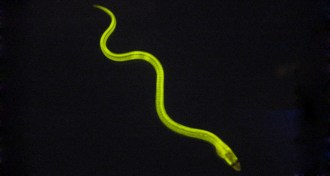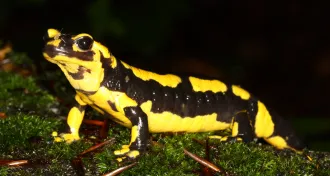Search Results for: Vertebrates
Skip to resultsCan’t find what you’re looking for? Visit our FAQ page.
1,539 results for: Vertebrates
-
 Animals
AnimalsFirst Impressions: Early view biases spider’s mate choice
In a new wrinkle on how females develop their tastes in males, a test has found that young female wolf spiders that see a male's courtship display grow up with a preference for that look in mates.
By Susan Milius -
 Chemistry
ChemistryAn eel’s glow could illuminate liver disease
Fluorescent protein binds to bilirubin, a compound the body must eliminate.
-
 Life
LifePrimitive fish could nod but not shake its head
Ancient fossils reveal surprises about early vertebrate necks, abdominal muscles.
By Erin Wayman -
 Animals
AnimalsNew fungus species found killing salamanders
First there was amphibian killer fungus Bd. Now there's Bs.
By Susan Milius -
 Genetics
GeneticsGenes for body symmetry may also control handedness
Lefties and righties can thank same genes that put hearts on left side for hand dominance, study of thousands of people’s DNA suggests.
-
 Humans
HumansLetters from the March 1, 2008, issue of Science News
Big evolvers Regarding “Whales Drink Sounds: Hearing may use an ancient path” (SN: 2/9/08, p. 84), I have heard that whales evolved millions of years ago into their present form, including their very large brains. We humans must be relatively recent in terms of our brain structures. Are there data concerning evolutionary development in whales? […]
By Science News -
 Health & Medicine
Health & MedicineThe two faces of prion proteins
Scientists are learning more about the protein behind mad cow and Creutzfeldt-Jakob disease, including how to interfere with the protein’s production in the brains of mice.
-
 Animals
AnimalsWe all sing like fish
From opera singers to toadfish, vertebrates may use basically similar circuitry for controlling vocal muscles.
By Susan Milius -
 Life
LifeHow the snake got its fangs
A study of snake embryos suggests that fangs evolved once, then moved around in the head to give today’s snakes a variety of bites.
By Amy Maxmen -
 Life
LifeFemale frogs play the field
A female frog insures a safe home for her young by mating with many males.
-
 Life
LifeClimate warms, creatures head for the hills
Unusual data let scientists test predictions that global warming drives species up slopes.
By Susan Milius -
 Genetics
GeneticsEvolution of venom, binge eating seen in snake DNA
Python and cobra genes evolved quickly to enable hunting strategies.